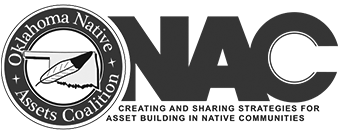The colorof wealthtulsa
Our partners
The Color of Wealth Tulsa report examined the wealth of Black American, Mexican, Native American, and White households residing in the Tulsa, Oklahoma Metropolitan Statistical Area. The findings presented in this report show that there is a clear racial, ethnic, and tribal pattern to assets, debts and wealth holdings in Tulsa. The report shows that White households have the highest asset holdings and often have some of the lowest burdens of debt. As a consequence, White households have the highest median net worth position in Tulsa. The report also shows that even though Native Americans have less wealth than White households, there are differences in wealth within the group.
Wealth matters for building an equitable and prosperous Tulsa region. Many studies focus on income– the amount of money people make in a certain period of time– for instance, your paycheck. Wealth, however, represents the store of resources you own. It is wealth that determines your ability to weather emergencies, move to a nice neighborhood, and make investments that enable you to grow your wealth.
How unequal is wealth in Tulsa?
Assets: A major driver of wealth inequality in Tulsa
Assets are key to understanding not only peoples’ current wealth, but their ability to hold onto and grow their resources. Someone who has a large store of liquid assets is better able to weather financial shocks and emergencies. People who own their homes and own stock are better able to grow their wealth. Significant racial disparities exist when considering total assets, liquid assets, stock ownership and homeownership. White families in Tulsa have higher rates of asset ownership and median asset values across the board.
Assets and financial well-being: Black
- Select a race/ethnicity
Tulsa
Median
Total assets
$12K
Median
Liquid assets
$0K
Percent with
Liquid assets
49%
Percent who
Own stock
5%
Percent who
Own their homes
44%
Debts: A look at inequality
Debt can be an important barrier to a family’s ability to build wealth. For instance, higher education can lead to both higher earnings and burdensome student loan debt.
In Tulsa, a notably higher percentage of Black families hold student debt. Higher percentages of Muscogee families hold student loan, medical, and unsecured debt.
Debts: Black
- Select a race/ethnicity
Tulsa
Percent with
Student loans
30%
Percent with
Medical debt
15%
Percent with
Unsecured debt
56%
Financial institutions and services
Payday loans are small, unsecured loans with high interest rates that individuals seek as last-resort emergency financing after other sources of credit have been exhausted. Users may intend to borrow and quickly return a small amount of money but instead find themselves in a cycle of debt.
The State of Oklahoma Department of Consumer Credit indicated that there were 320 payday lenders in the state with the majority concentrated in Oklahoma City and Tulsa. Lenders in the state tend to target economically vulnerable populations and especially those serving in the military.
Looking closely at payday loan usage in Tulsa, Muscogee households were most likely to use payday lending. This was over twice that of respondents who were Cherokee, Other Tribal Enrollment, American Indian with No Tribal enrollment, and Black. Additionally, US born Mexicans were three times as likely to use payday loans than their immigrant counterparts. A larger percentage of White respondents used payday loans in Tulsa than in any of the other metropolitan areas where Color of Wealth studies have been conducted.
Financial Services, Access and Quality: Black
- Select a race/ethnicity
Tulsa
Percent with
Bank accounts
49%
Percent with
Payday lending usage
16%
About and credits
About the project
The Color of Wealth Tulsa report examined the wealth position of Black American, Mexican, Native American, and White households residing in the Tulsa, Oklahoma Metropolitan Statistical Area. The findings presented in this report show that there is a clear racial, ethnic, and tribal pattern to assets, debts and wealth holdings in Tulsa. The report shows that White households have the highest asset holdings and often have some of the lowest burdens of debt. As a consequence, White households have the highest median net worth position in Tulsa. The report also shows that even though Native Americans have less wealth than White households, there are differences in wealth within the group.
Methodology & data collection
The Color of Wealth in Tulsa data was collected towards the end of 2013 and primarily in 2014. The research team used a variety of techniques to generate the sample, including obtaining directory-listed landline and cell phone random digit samples in census tracts and zip codes where target ethnic groups were known to reside in the Tulsa metropolitan statistical area. Other techniques included the use of surname based lists targeting specific national origin groups. For this study, a total of 396 surveys were completed.
Credits & thanks
This project was made possible by the generous support of the Ford Foundation’s Building Economic Security Over a Lifetime (BESOL) initiative. We are grateful to the team at the Justice for Greenwood Foundation and Christy Finsel (Osage) at the Oklahoma Native Assets Coalition, Inc. Graphicacy worked with the Institute team to visualize the data from the Color of Wealth Tulsa study.



